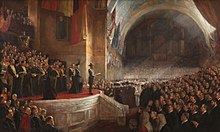Tom Roberts
Tom Roberts | |
|---|---|
 Portrait taken c.1920-1925 | |
| Born | 9 March 1856 Dorchester, Dorset, England |
| Died | 14 September 1931 (aged 75) 'Talisman' in Kallista |
| Resting place | Illawarra churchyard, near Longford, Tasmania |
| Other names | Nickname Bulldog |
| Occupation | Artist |
| Spouse(s) |
Elizabeth (Lillie) Williamson
(m. 1896–1928)Jean Boyes (m. 1928–1931) |
| Parent | (Father) Richard Roberts (Mother) Matilda |



Thomas William "Tom" Roberts (9 March 1856 – 14 September 1931) was a prominent Australian artist and a key member of the Heidelberg School.
Life
Born in Dorchester, Dorset, England, where his parents were newspaper editors, Roberts migrated with his family to Australia in 1869. Settling in Collingwood, a suburb of Melbourne, Victoria, he worked as a photographer's assistant through the 1870s while studying art at night under Louis Buvelot and befriending others who were to become prominent artists, notably Frederick McCubbin. He returned to England for three years of full-time art study at the Royal Academy Schools from 1881 to 1884.
Through the 1880s and 1890s he worked in Victoria, in his studio at the famous studio complex of Grosvenor Chambers at 9 Collins Street in Melbourne, and at a number of artists' camps and visits around the colony. He married 35 year old Elizabeth (Lillie) Williamson in 1896, and they had a son, Caleb. Many of his most famous paintings come from this period. Roberts was an expert maker of picture frames, and during the period 1903-1914, when he painted relatively little, much of his income apparently came from this work.
He spent World War I in England assisting at a hospital. In Australia, he built a house at Kallista, near Melbourne. This was a particularly productive and happy period in Roberts' life.
Elizabeth died in January 1928, and Tom remarried, to Jean Boyes, in August 1928. He died in 1931 of cancer in Kallista near Melbourne. He is buried near near Longford, Tasmania.
Works
Roberts painted a considerable number of fine oil landscapes and portraits, some painted at artist camps with his friend McCubbin, but perhaps his most famous works, in his time, were two large works, Shearing the Rams and The Big Picture.
Shearing the Rams, based on a visit to a sheep station (large farm) at Brocklesby in southern New South Wales, depicted the wool industry that had been Australia's first export industry and a staple of rural life. At the time it was exhibited, it was criticized because many critics did not feel that it fitted the definition of 'high art'. However, since the wool industry was Australia's greatest export industry at the time, it was a theme which many Australian people could identify with. The painting showed a view of the shearing sheds which was not in some cases realistic. Shearing would probably have been much messier; for instance the shearer on the left has picked the ram up to move it, when normally it would have been dragged backwards.
Roberts loved this theme because it valued the work of ordinary Australian people. He made many other paintings showing country people working, with a similar image of the shearing sheds in The Golden Fleece, a drover racing after sheep breaking away from the flock in A break away!, and with men chopping trees in Wood splitters. Many of Roberts' paintings were landscapes or ideas done on small canvases that he did very quickly, such as his exhibits at the famous "9 by 5 Impression Exhibition" in Melbourne, "9 by 5" referring to the size in inches of the cigar box lids which most of the paintings were done on. Roberts had more works on display in this exhibition than anyone else. Many of the paintings had humorous touches and anecdotes, showing Roberts' sense of humor.
The Big Picture, a depiction of the first sitting of the Parliament of Australia, was an enormous work, very notable for the event depicted as well as the quality of Roberts' work. Many examples of Roberts' work can be seen at the National Gallery of Australia, but The Big Picture is displayed at Parliament House, Canberra.
References

- Topliss, Helen. "Roberts, Thomas William (Tom) (1856 - 1931)". Australian Dictionary of Biography. Australian National University. Retrieved 5 June 2007.
- ToplisslA Catalolgue Raisonne Volumes I and II (1985lkml). Oxford University Press, USA. pp. 544 pages. ISBN 0195545133.
{{cite book}}: Check date values in:|date=(help); Missing or empty|title=(help)
External links
- Tom Roberts on Picture Australia
- artistsfootsteps.com - source of most of the material for this article.
- ngv.vic.gov.au - TOM ROBERTS Collection at the National Gallery of Victoria.
